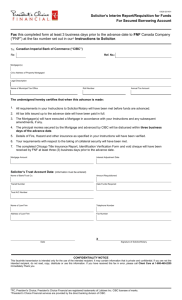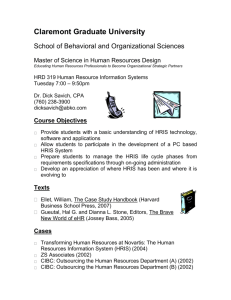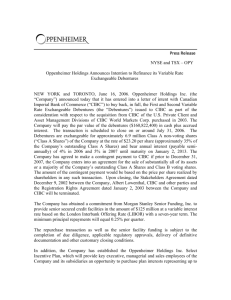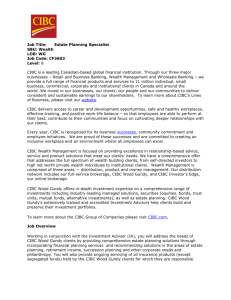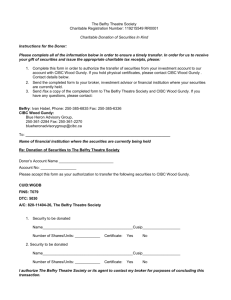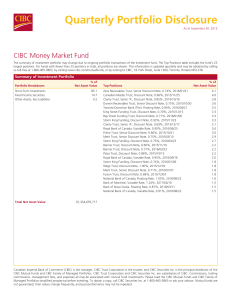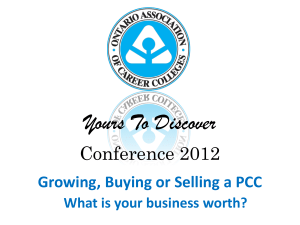MARKETING STRATEGY
advertisement
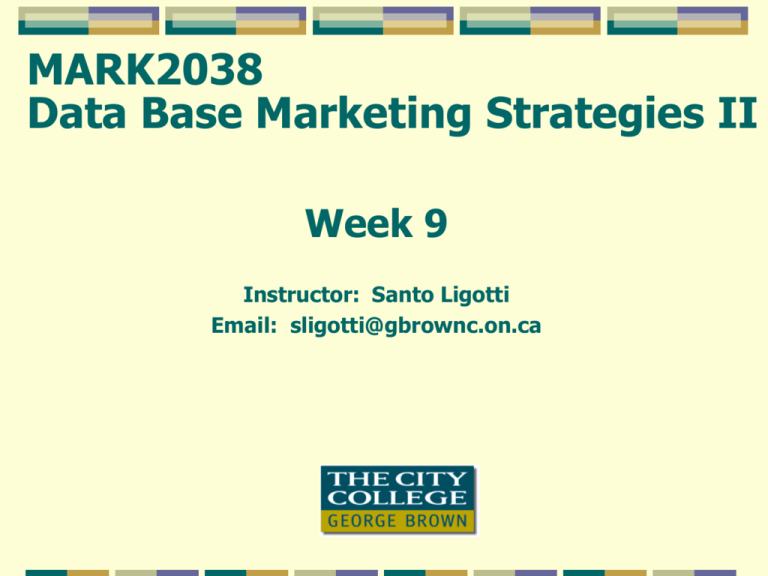
MARK2038 Data Base Marketing Strategies II Week 9 Instructor: Santo Ligotti Email: sligotti@gbrownc.on.ca Digital Marketing-Part II This week Assignment 4 due Effective Internet Advertising Effective E-mail marketing in DM Viral Marketing and Wireless applications Internet Advertising Facts we know:* Canada is one of the most wired countries in the world Canadian Internet penetration is growing overall, which means marketers have more opportunities to touch consumers than ever before Home Internet penetration is steadily on the rise The Internet continues to attract more tightly focused interest groups to niche site categories High speed connectivity continues to grow and with it the opportunity to reach Canadians faster, and with more technologically sophisticated messages On-line ad spending will surge to $18.9 Billion by 2010-up 59% from an estimated $11.9 Billion in 2005. Growth will remain steady, rather than filled with spikes or valleys. This reflects the stability of the industry, both in terms of the players involved and their business practices *Source: The Internet Advertising Handbook Internet Advertising Integrating online advertising seamlessly into the overall media plan means keeping an open mind about the various ways that the Internet can generate consumer impact There are key questions you should ask yourself in considering when to integrate online media into an overall media plan Does the message reach Internet users at important touch points? In a mass media campaign, is there a compelling reason for consumers to visit online, or will you simply be duplicating offline messages? Does you want to create a cool factor? How will response be generated and measured? Do you want to sustain a long echo? Five ways to achieve Great Online Creative 1. 2. 3. 4. 5. Keep it Simple Never compromise the brand Mix it up If you don’ see it, ask Define your key metric before you conceive creative Fifteen Reasons to Advertise Online 1. 2. 3. 4. 5. 6. 7. 8. 9. 10. 11. 12. 13. 14. 15. Generate trial of product or service for first time buyers Increase brand awareness Increase use of the brand Cross-sell other brands from the same company Encourage brand loyalty Provide in-depth information about the brand and related products Develop a database of customers, collect sales leads Provide or improve customer service Test different copy concepts and pricing models Generate online revenues Reach a target audience missed by other media Drive traffic to a retail location Recruit employees Target by speed Drive traffic to a marketer’s web site Popular On-Line Ad Sizes •Strategically positioned squares and rectangles •Tall, vertical banner ad Source: Internet Advertising Handbook •A variety of banners and buttons from the size of a business card to a postage stamp Negotiating the On-line AD BUY Questions for you to ask your media buyer Where does the demographic information come from? What are the behaviour patterns of the users? What are the other on-line advertising opportunities, like content solutions (cobrands), sponsorship, and e-mail? Is the host web site able to accommodate rich media? How ill you measure your campaign and who will do the tracking? Source: Internet Advertising Handbook Common ON-line Pricing Models The most common pricing scheme for on-line ads remains the CPM, or cost per 1,000 impressions. Most widely recognized pricing system Seen in over 90% of on-line publishing rate cards CPM: COST PER THOUSAND: With cost per thousand models, the publisher sets the boundary for pricing CPA: COST PER ACTION: The advertiser only pays when someone actually registers or purchases something right then and there. Low risk for the advertiser. Site publisher takes a commission on all sales generated. Usually a formal audit procedure exists between the advertiser and the publisher to track sales or registrations to determine payments CPC: COST PER CLICK: A payment model in which an advertiser pays only for the number of click-throughs it derives from an ad rather than paying a flat rate to run an ad on site CPL COST PER LEAD: An on line advertising payment model in which an advertiser pays based solely on the number of qualifying leads FLAT RATE: An advertiser rents a space on line and pays a lump sum for that piece of real estate. Sponsorship is a good example. The sponsorship runs in a content area that is a relevant fit with the ad message, locking out the competition from advertising in that space Source: Internet Advertising Handbook Web Measurement Success Factors-A FEW WORDS Customers continue to move from traditional media to on line media, with many emerging as INTERNET ONLY consumers A growing number are accessing content from mobile devices anywhere, anytime, adding yet another variable to the e-content consumer demographic mix Successful determination of web analytics and key performance indicators is paramount Our lecture on measurement in WEEK 11 will discuss the importance of overall measurement, but also channel specific measurement (WEB MEASUREMENT WILL BE KEY STAY TUNED Common Tactics 1. 2. 3. E-mail Viral marketing Wireless applications Typically, responses are directed to a Web site where the user can get more information and/or purchase. Why use email to communicate with customers? And what drives the success of this communication vehicle? Why email? • Smart email marketing maintains trust-based customer relationships • Fast, cost-efficient communication vehicle • Can provide rich, dynamic information • Efficiency to market, timeliness • Fulfills customer expectations for channel of choice The 4 P’s help to ensure successful email marketing: • Obtain permission from the best customers • Maintain strict privacy with the information • Profile the whole customer • Send personalized content Source: The Canadian Inter@active Reid Report. “Email Marketing 2005: The Resurgence of the Medium” Winter 2004 Ipsos/Reid Best Practices for Email communication • Sell the value of receiving email to customers - Explain how the customer will benefit from receiving email communication (e.g., receive time-limited product offers, updates on product features) • Make email registration easy for the customer - Provide email address via multiple channels • Immediate confirmation of receipt of email address - Immediate acknowledgement should be sent out that email addresses have been registered • Advise the customer about what kinds of messages they should expect to receive - e.g. special offers and incentives, product and service solutions, and channel enhancements • Ask the customer about their preferences to ascertain what is relevant to them - This enables us to respond to their needs with appropriate product and service solutions • Ask questions to determine customer types beyond demographics - e.g. Determine various life stages that may not be apparent from customer data; age may be independent of when a customer becomes a first time homebuyer or new parent • Time the emails to match the customer purchase process - Emails are sent to the customer to coincide with the timing of a known life goal or life event • Allow customers to change their preferences for information that is sent to them - The customer should be able to change their email content preferences so that email content remains relevant to them Best Practices for Email communication • Unsubscribe and email address change options are always available - The customer should be able to opt out of email communication or change their email address through various channels; this option will also be available at the bottom of every email How does CIBC collect and verify email addresses? • Email address collection and verification can be bundled with existing direct marketing programs (TB,DM,INTERNET) or email collection can be done as a stand alone program (INTERNET) • Verification should include confirmation that company can use the email address, and specify what it will be used for; email must only be employed for those purposes identified (CMA Standard) • The company’s Privacy Policy will be provided wherever email collection is being sourced, as well as the company’s web site (CMA Standard) • Promote the benefits of providing an email address (receive timesensitive offers, product feature updates, privacy ensured) What is emailed? The following are some guidlelines as to what should appear on all outgoing email marketing communication: “From” address should be clientsponsor@cibc.com A clear subject line and body text in the communication that accurately reflects the content, origin and purpose of the communication. (CMA standard) Note that titles such as “Free offers” or “Winning prizes” should be avoided as many spam filters use these key words as a signal that the email is spam. Please refer to the appendix for a detailed list of examples of other spam filters. Acknowledgement of the customer’s name. Examples: Dear Joe, or Dear Joe Smith: The email marketing message may acknowledge a customer’s product ownership but will not contain any account, password, credit limit or balance information. “Please do not reply to this email” text which advises customers not to reply to the email. Email replies are sent to the clientsponsor@cibc.com mailbox which is monitored by a designated group. They are able to answer questions relating to the email, but will not fulfill requests for customer or account information, unsubscribing to future marketing or transaction requests. The email should contain a phone number for the company The email should be available in English and French (The language that the email is sent in will be based on the customer’s language preference) What is emailed? (cont’d) The email is required to be be created in two versions (HTML and text), although only one version of the email will be sent. The email must be mapped to a static HTML page on a website in the event that the targeted email is not viewable All email images are required to map back to the company’s main web site • There should be no direct hyperlinks to the main web site. Phishing emails often contain links to phony sites that collect IDs, account information and passwords. • Customers are asked to type in www.cibc.com in their browser. Hyperlinks to content splash pages, tools and information pages and unsubscribe pages are permitted. (Note that these pages do not collect personally identifying information) Company Privacy Policy (Accessible via hyperlink) Opt-out information allowing a customer to unsubscribe to email marketing (CMA standard). The instructions that a customer should follow to update their email address (to continue to receive further email communication). Changes to customer email address information can be made through Online Banking, at the branch or through Telephone Banking. Opting out and email replies • CIBC will always provide unsubscribe capability to all outgoing emails • Customers can also change their opt-out preferences through Telephone Banking or the Branch • An unsubscribe request for email marketing applies to all product communication through the email marketing channel • Need consistent opt-out language and an estimated timeframe of how long it takes to have the email address removed. Example: In the past you have provided us with your email address. As a result, CIBC Credit Card Services may occasionally send you relevant information about new or existing products and services. If you no longer wish to receive future communication, you can unsubscribe by clicking here. Please note that your request to change your Do Not Solicit Email preference may take up to 90 days to process. • The Clientsponsor@cibc.com mailbox will be monitored by Internet Channel Correspondence Team (ICCT). ICCT can answer customer questions and direct customers to the appropriate channels for opt out requests, however ICCT will not be involved in actual opt-out request fulfillment. How to send an email?-CIBC EXAMPLE ICCT (Internet channel correspondence team) is briefed on all upcoming email marketing campaign programs, including timing, content and projected volumes Marketing pulls the list of names based on campaign criteria and business rules List is sent from Marketing to Agency Agency to have an email deployment tool (such as Maestro), of which CIBC purchases a onetime use [nb: creative, copy, and visuals are hosted at CIBC (HTML and text)] The tool uses the list of names and sources the creative through the CIBC host so that the email is sent from CIBC [the “From” address should be: clientsponsor@cibc.com e.g. PersonalDeposits@cibc.com would be the appropriate address for a GIC and Deposits sponsored campaign After the data file is received by the agency, the agency sends data dumps to Marketing and there is a test run of the email deployment to the email seed list to ensure correct formatting (3 days after data file receipt by the agency) The email is sent to customers 2 days after the email test run by the agency The tool automatically tracks raw clicks, open rates, unsubscribes, bouncebacks (invalid email address or email box is full) as well as click-throughs, and web-tracking. (Splash pages must map back to a cibc.com address). • How to send an email?-CIBC EXAMPLE If a customer hits reply, the response goes back to clientsponsor@cibc.com for updating or response. The Internet channel correspondence team will answer questions that come through by email. E.g. Is this an authentic email from CIBC? ICCT is not able to fulfill any customer requests via email. E.g. ICCT cannot take GIC renewal instructions via email, change email addresses or take DNS change requests. Using the unsubscribe and email bounceback results, CIF is updated with the most accurate email address information using an automated batch process. CIBC Visa flags invalid email addresses and unsubscribes from the CIBC Visa database. CIRM and Visa are developing a process to enable Visa unsubscribe email requests and invalid email addresses to be captured in CIF. Example: Solicitation preference for all products email marketing will be changed to “N” for all unsubscribe email requests Invalid email addresses will be removed from CIF (there will be no corresponding change to the customer’s email solicitation preference) Best Practice Summary Table Best practice criteria Expedia Opt-in •Characteristics set by client • Permission • Value Relevant as content is determined by client preferences Determined according to customer preferences (travel types, airline routes) • Brevity Interaction Source Unknown Forrester Wells Fargo Opt-in •Characteristics set by client • Relevant as content is determined by client preferences • Determined according to customer preferences (product types, rates) • Kraft Opt-in •Characteristics set by client •Frequency determined by client (daily, weekly, biweekly) • Relevant as content is determined by client preferences • Determined according to customer preferences (type of recipes, cooking for singles, couples, families, occasions) • Motley Fool Opt-in •Characteristics set by client • Relevant as content is determined by client preferences • Determined according to customer “profile” (serious investor, conservative, novice investor) • Unknown Links embedded in the email Unknown Forrester Relationship Marketing Forrester Best practices –Sell the value of receiving email to customers Best practices – Make email registration easy for the customer Best practices –Immediate confirmation of receipt of email address •JC Penney confirms receipt of registration immediately Best practices – Advise the customer about what kind of message that they should expect to receive Best practices – Ask the customer about their preferences to ascertain what is relevant to them Expedia customers classify the offers and vacation types that motivate them to travel to their favorite destinations Best practices – The Motley Fool asks questions to determine customer types beyond demographics The Motley Fool uses personas to fuel email content Best practices - Time the emails to match the customer purchase process Wells Fargo times emails to match customer purchase processes Best practices - Unsubscribe and email address change options are always available TheStreet.com gives users a chance to change their registration in every email Avoiding spam filter: what to avoid Subject Line Characteristics to Avoid Subject contains a unique ID Subject contains a UCE tag (Unsolicited Commercial EMAIL) Subject contains G.a.p.p.y-T.e.x.t Subject contains lots of white space Subject contains too many raw illegal characters Subject has exclamation mark and question mark Subject has many exclamations Subject is all capitals Subject is missing Subject starts with dollar amount Avoiding spam filter: what to avoid Subject line characteristics, line words and phrases to avoid amazing as seen as seen on attention avoid bankruptcy buy buy direct buying call now ! cash cash bonus casino cialis click here collect compare consolidate your debt unsecured debt urgent vacation reverses aging satisfaction guaranteed save up to search engine listings serious cash core credit discount! don't delete double your income earn $ easy terms eliminate debt explicit for only free! get paid give it aw ay giving it aw ay great offer guarantee guaranteed xanax w ork at home w eight sex slut soma special promotion stop hard-core hardcore hello hidden information you requested join millions lbs lesbian levitra life insurance loans lose lose w eight losing meet singles million dollars misc viagra vicodin visit our w eb site stops subject to credit approval subscribe taboo teen mlm multi level marketing naughty no cost no fees offer one time online marketing online pharmacy opportunity order now phentermine please read porn pounds promise you removes w hile supplies last w hy pay more? w inner time limited unsecured you're a w inner! you've been selected your bills/credit/family Criteria for success for direct marketing and email marketing campaigns Existing direct marketing programs at CIBC use some of the following measurement criteria: (1) Response rate lift (Contact vs. Control) (2) Total and incremental number of responders from contact (3) Total and incremental product balances from contact (4) Responders’ usage of product or service (5) Change in customer’s total funds managed (6) Reduction in product attrition and customer attrition Additional factors to be included that can determine the success of an email marketing campaign: (7) Number of successfully delivered emails, hardbounce, softbounce (undeliverable emails) and Email unsubscribes (8) Raw clicks (9) Open rates (including the number of times that an email was opened) (10) View time rates (11) Forward rates (forwarding the email to another email address) Phishing and online fraud What is phishing?: •Also known as brand spoofing •Using fraudulent email and web pages to gather personal, financial and sensitive Information for the purposes of identity theft How is phishing carried out? •Customers receive spam email (mass non permissioned email messaging) or pop up windows that appear to come from legitimate businesses •Customers are asked to personal or financial confidential information such as passwords, account or social insurance numbers •The message may contain a link that leads to a fraudulent website or pop up window •Messages usually have an urgent tone and suggestions that failure to respond may result in risk to accounts or credit cards at CIBC •Phishing emails may even contain “credible” information in the subject title such as Source: CIBC website the customer’s name and last four digits of their bank account number (information which may have been stolen from a legitimate FI email) Phishing and online fraud (cont’d) Signs that your message may be a phishing email: Spelling mistakes and poor grammar e.g. Atention, Update your CIBc records, Tecnhical issues (2) The address of the sender (“From”) may be @cibc, however, the actual e-mail address itself is not from CIBC. E.g. the email may be From: CIBC Service, but the actual email address is 123@123.com. (The actual email address sender can be determined by clicking on the address and selecting “Properties”. (3) Poor branding (4) The email does not contain a valid URL (5) Communication uses words such as mandatory, reactivate, unexplained funds depletion Source: CIBC wesbite Advantages of E-mail over postal direct mail No postage or printing charges: average cost e-mail message < $0.01, direct mail $.50 to $2.00. Offers an immediate and convenient avenue for direct response (hyperlinks to Web sites using). Can be automatically individualized to meet the needs of specific users. Solution: Permission Marketing 1. Ask people what they are interested in. 2. Target meaningful offers to the individual. 3. Ask permission to send them information Do it in an entertaining, educational, or interesting manner Track results and gain knowledge. Gather information about customer needs, interests, and backgrounds to deepen relationships Timely E-mail Delights Customers Screen: Thank you for your order! E-mail: Thank you for your order! E-mail: Your order will shipped on… E-mail: Your order is in transit! E-mail: Was everything to your satisfaction? Cost to send of all of the above: $0. Building an E-mail List E-mail lists are hard to obtain and maintain. There are three ways to build a list: 1. 2. 3. House list (generated through Web site registrations, subscription registrations, or purchase records) Harvest e-mail addresses from relevant discussion groups or bulletin boards Rent from a list broker (i.e., CORNERSTONE) With individuals having more than 1 e-mail address it is very difficult to match them with individual customers and prospects in a firm’s database. Viral Marketing Viral marketing: a combination of email marketing and word of mouth. Uses the power of referrals Encourages prospects to forward e-mail to friends, co-workers, family, and others Marketers must be careful not to invade or exploit customers e-mail Example – Hotmail Hotmail started with only a $50,000 promotion budget: Every message tagged with a promotional signature file 6 months later, 1 million subscribers 18 months later, 12 million subscribers Microsoft acquired the firm for $400 million in stock. Examples http://www.zzzzzzzzz.com.br/ http://www.comeclean.com/ http://www.oooooouch.com/ http://www.hangingtestdummy.com/ http://www.entertainmentanytime.com/ Wireless Internet Applications E-marketing applied to mobile devices. SMS (Short-text messages) Instant Messaging 600 billion short text messages a month were flying between mobile phones worldwide by the end of 2006. SMS Marketing Examples VOTING: Voting is an exciting way to engage your audience and let them have their say. Newspapers, magazine and television are prime examples. Big Brother 3 claimed 3 million votes. Think not only of the revenue generated by voting alone, but the opportunity to offer other mobile services such as text alerts, ring tones, logos etc Instant Win We can deliver exciting instant win prizes where customers can find out if they have won a prize straight away. We use a very clever random winner selection process. There is no need to fear that there will be too many instant winners as Dragon will no longer select winners once all prizes have been claimed. You can have multiple prizes i.e. 20 games consoles, 100 console games, 1,000 ring tones as instant prizes. Dragon can also deliver mobile content such as ring tones, logos, java games etc as instant runner-up prizes. Location Based Services (PROXIMITY MARKETING) To drive footfalls into your nearest store, bar, club, theatre, cinema, gas station etc, you may wish to consider using location based campaigns. You simply request the user to text in permission for us to track them down via the mobile phone. Accuracy can be as good as 100 metres in the cities SMS Example: Heineken Heineken, used an SMS sales promotion to capitalize on the British pub tradition of quiz nights: P.O.P. signs in pubs inviting customers to call a phone number from cell phones and type in the word “play” as a text message. The customer received a series of 3 multiple choice questions to answer. Correctly answering all the questions scored a food or beverage prize (special verifiable number to the bartender) and 20% of all players won. Feedback = a great promotion...consumers found it fun + sellers found it to be a hook. Location-Based (Proximity) Marketing Location-based marketing: Promotional offers that are pushed to mobile devices and customized based on the user’s physical location. A global positioning system (GPS) in a handheld device or automobile Plus user address information stored in a database. Location-Based Marketing From a marketers perspective the advent of location-based marketing can include many benefits: A captured target. The consumer is already in or near your place of business. Remember, this is location-based marketing. A customer is much more likely to come through your door if a competitors store is a twenty minute drive away, but your store happens to be right around the corner from where they are standing. Increased Impulse buying. Real time delivery of advertising prompting benefits of immediate response. Example; Come in within the next 30 minutes and receive 20% off your meal. Development of one-to-one relationship marketing. Consumer purchasing history can be examined, thereby enhancing future marketing messages. Direct marketing spending effectiveness. True targeting of promotional materials. Materials are delivered electronically and on demand, as required. No hard copy waste or excess printing inventory. Psychological Nurturing. The consumer 'feels like a somebody,' building brand recognition and loyalty. Increased return on investment (ROI) Repeat or additional consumer purchases during a visit. BLUE TOOTH TECHNOLOGY Definition: BlueTooth is a specification for the use of lowpower radio communications to wirelessly link phones, computers and other network devices over short distances. The name "Bluetooth" is borrowed from Harald Bluetooth, a king in Denmark more than 1,000 years ago. Media Comparison Chart Criterion TV Radio Magazine Newspaper Direct Mail Involvement passive passive active active active Interactive Media Richness multimedia audio text and graphic text and graphic text and graphic multi-media Geographic Coverage global local global local varies Global CPM low lowest high medium high medium Reach high medium low medium varies medium Targeting good good excellent good excellent excellent Track effectiveness fair fair fair fair excellent excellent Message flexibility poor good poor good excellent excellent E-Mktg

